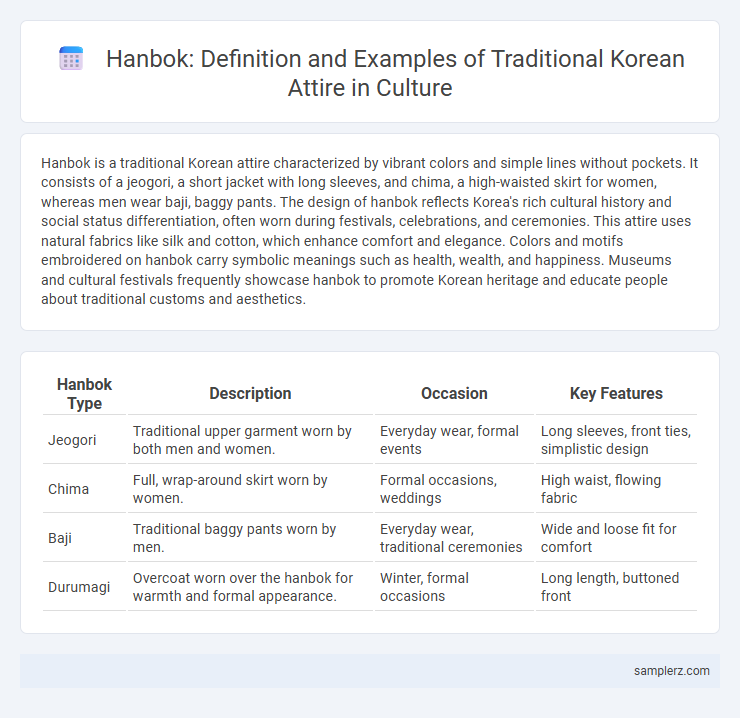Hanbok is a traditional Korean attire characterized by vibrant colors and simple lines without pockets. It consists of a jeogori, a short jacket with long sleeves, and chima, a high-waisted skirt for women, whereas men wear baji, baggy pants. The design of hanbok reflects Korea's rich cultural history and social status differentiation, often worn during festivals, celebrations, and ceremonies. This attire uses natural fabrics like silk and cotton, which enhance comfort and elegance. Colors and motifs embroidered on hanbok carry symbolic meanings such as health, wealth, and happiness. Museums and cultural festivals frequently showcase hanbok to promote Korean heritage and educate people about traditional customs and aesthetics.
Table of Comparison
| Hanbok Type | Description | Occasion | Key Features |
|---|---|---|---|
| Jeogori | Traditional upper garment worn by both men and women. | Everyday wear, formal events | Long sleeves, front ties, simplistic design |
| Chima | Full, wrap-around skirt worn by women. | Formal occasions, weddings | High waist, flowing fabric |
| Baji | Traditional baggy pants worn by men. | Everyday wear, traditional ceremonies | Wide and loose fit for comfort |
| Durumagi | Overcoat worn over the hanbok for warmth and formal appearance. | Winter, formal occasions | Long length, buttoned front |
Traditional Elements of Hanbok in Contemporary Fashion
Traditional elements of hanbok, such as the jeogori (jacket) and chima (skirt), are increasingly integrated into contemporary fashion through modern cuts and fabrics. Designers often preserve the garment's signature vibrant colors and flowing silhouettes while adapting them for everyday wear, blending heritage with modern aesthetics. This fusion not only revitalizes the hanbok's cultural significance but also appeals to global fashion trends by highlighting Korea's rich sartorial history.
Iconic Hanbok Styles Through Korean History
Iconic hanbok styles such as the Joseon Dynasty's jeogori and chima showcase the elegance and simplicity of Korean traditional attire, characterized by vibrant colors and flowing lines. The ceremonial dangui, worn by noblewomen during special occasions, highlights intricate embroidery and delicate fabrics symbolizing status and grace. Modern adaptations blend classic hanbok elements with contemporary fashion, preserving cultural heritage while appealing to today's stylistic preferences.
Hanbok Attire in Korean Ceremonies and Festivals
Hanbok attire holds significant cultural value in Korean ceremonies and festivals, symbolizing tradition and identity through its vibrant colors and flowing designs. Commonly worn during events like Chuseok and Seollal, the hanbok reflects historical styles tailored for respect and celebration. The intricate embroidery and specific garment components, such as jeogori and chima, showcase the craftsmanship unique to Korean heritage.
Modern Interpretations of Hanbok in Daily Wear
Modern interpretations of hanbok integrate traditional Korean design with contemporary fabrics and silhouettes, making it suitable for everyday wear. Designers incorporate elements such as shortened jeogori jackets and simplified chima skirts, enabling ease of movement while preserving cultural aesthetics. This fusion not only revitalizes hanbok's relevance in urban fashion but also promotes Korean heritage globally.
Hanbok-Inspired Attire in Popular Korean Media
Hanbok-inspired attire in popular Korean media showcases traditional design elements such as vibrant colors and elegant lines while adapting to contemporary fashion trends. Korean dramas and films often feature modified hanboks that blend modern fabrics and silhouettes, appealing to global audiences. This fusion highlights Korea's cultural heritage and promotes hanbok as a symbol of national identity in the entertainment industry.
Unique Hanbok Designs Across Korean Regions
Hanbok designs vary distinctly across Korean regions, showcasing unique cultural identities through differences in color schemes, fabric choices, and embroidery patterns. In Jeju Island, hanboks often feature lighter fabrics and pastel colors suited to the coastal climate, while Gyeonggi province is known for its use of vibrant silk and intricate floral motifs. These regional variations reflect localized traditions and environmental influences, making each hanbok design a rich representation of Korea's diverse cultural heritage.
Hanbok in Korean Weddings: A Cultural Symbol
Hanbok, the traditional Korean attire, is prominently featured in Korean weddings, symbolizing cultural heritage and auspiciousness. The vibrant colors and intricate embroidery of wedding hanboks represent wishes for prosperity, happiness, and fertility. Wearing hanbok during ceremonies connects couples to their ancestors and underscores the importance of tradition in contemporary Korean culture.
Children's Hanbok: Tradition and Trends
Children's hanbok combines traditional Korean cultural elements with contemporary trends, featuring vibrant colors and simplified designs for comfort and ease of movement. The attire maintains the hallmark jeogori (jacket) and chima (skirt) or baji (pants), often adorned with playful patterns reflecting youthful energy. Modern adaptations include softer fabrics and adjustable features, ensuring practicality while preserving the symbolic significance of Korean heritage in children's fashion.
Hanbok Accessories: Completing the Traditional Look
Hanbok accessories such as norigae, jokduri, and binyeo play a crucial role in completing the traditional Korean attire by enhancing both elegance and symbolism. Norigae, often intricately embroidered, serves as a decorative pendant hanging from the jeogori or chima, while jokduri and binyeo are ornamental headpieces that signify social status and occasion. These accessories not only complement the vibrant colors and flowing lines of the hanbok but also reflect cultural heritage and historical aesthetics.
Global Influence: Hanbok on the International Stage
Hanbok, the traditional Korean attire, has gained significant global influence as it appears in international fashion shows, museums, and film industries worldwide. Its unique silhouette and vibrant colors have inspired designers across continents, blending traditional elements with contemporary fashion. The hanbok's presence on the global stage highlights Korea's cultural heritage while promoting cross-cultural appreciation and innovation.

example of hanbok in attire Infographic
 samplerz.com
samplerz.com